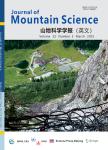Ectomycorrhiza of Larix sibirica Ledeb. along the gradients of main ecological factors and elevation at the Northern and Subpolar Urals
Ectomycorrhiza of Larix sibirica Ledeb. along the gradients of main ecological factors and elevation at the Northern and Subpolar Urals作者机构:Institute of Biology of Komi Scientific Centre of the Ural Branch of the Russian Academy of Sciences RussiaSyktyvkarKommunistieheskaya str28Syktyvkar167000Russian Federation
出 版 物:《Journal of Mountain Science》 (山地科学学报(英文))
年 卷 期:2018年第15卷第12期
页 面:2603-2613页
核心收录:
学科分类:07[理学]
基 金:funded by Russian Academy of Science (project no 0414-2018-0004 “Spatial and temporal dynamics of structure and productivity of forest and mire ecosystems at the Northeast European Russia”) Russian Foundation of Basic Research (project no 16-04-00749)
主 题:Ectomycorrhiza Larix sibirica Anatomy Fungal mantles diversity Elevation Urals
摘 要:Siberian larch(Larix sibirica Ledeb.) forests cover the largest areas in the Eurasian boreal zone, but there are insufficient data on its root system including the structure and functional traits of ectomycorrhizas(EM). The aim of this research is to find out if the morphological parameters of Larix sibirica EMs responded to the changes in elevation and main ecological factors(soil humidity, soil richness, soil acidity and habitat illumination). Using light microscopy, we studied EM diameter, root diameter, mantle width, and mantle volume share, share of tannin cells layers, EM density and EM length of Larix sibirica in two main types of plant communities along the elevation gradient at the Northern and Subpolar Urals. Differences in the environment were traced using phytoindication approach and the Ellenberg ecological scales. All the studied traits depend on the elevation and studied ecological factors. The diversity of fungal mantles is low, and the proportion of unstructured and pseudoparenchymatous mantles is high in response to the deterioration of the humidity, soil nitrogen content and acidity at higher-altitude habitats. Results of EM quantitative parameters measurements confirmed this pattern. We found a decline in the EM linear dimensions accompanied by a compensatory growth of the EM density with the raised elevation and the deterioration of environmental conditions.




